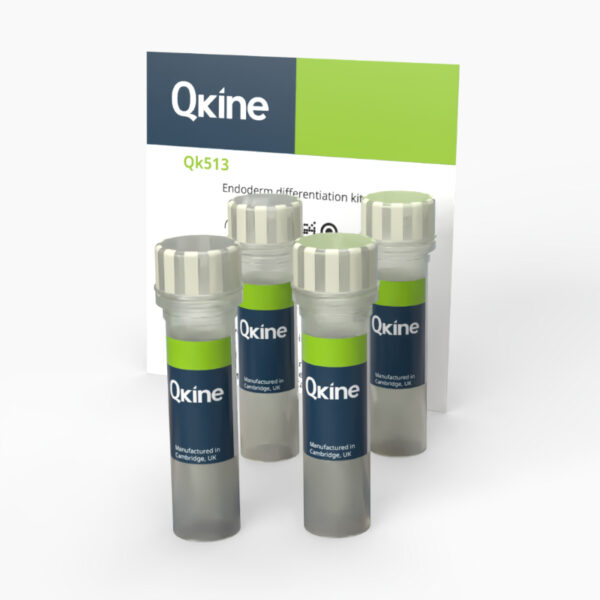Endoderm differentiation kit
QK513
Brand: Qkine
For validating the ability of new or established induced pluripotent stem cell (iPSC) lines to differentiate into the endoderm lineage.
The endoderm differentiation kit is designed to validate the differentiation potential of both newly derived and established iPSC lines. This kit enables the evaluation of the ability of iPSCs to differentiate into the endoderm linage, one of the three primary germ layers responsible for forming the respiratory and digestive systems, as well as organs such as the liver, pancreas, and intestines.
The kit includes carefully optimized growth factors and extracellular matrix required to efficiently guide iPSCs toward the endoderm lineage. It serves as both an endpoint assay, confirming pluripotency and lineage commitment, and a platform for generating endoderm-derived cells for further downstream applications.
Each kit is sufficient for differentiation of 5x 96 well plates.

Currency:
| Product name | Catalog number | Pack size | Price | Price (USD) | Price (GBP) | Price (EUR) |
|---|---|---|---|---|---|---|
| Endoderm differentiation kit | QK513 | 1 kit | (select above) | $ 525.00 | £ 405.00 | € 473.00 |
Note: prices shown do not include shipping and handling charges.
Qkine company name and logo are the property of Qkine Ltd. UK.
Summary
- >98%, by SDS-PAGE quantitative densitometry
- Animal origin-free (AOF) and carrier protein-free
- Expressed in E. coli
- Bioactivity Guaranteed
- Manufactured in Qkine's Cambridge, UK laboratories
- Lyophilized
- See reconstitution instructions for individual kit components
Further quality assays
- Mass spectrometry: single species with expected mass
- Recovery from stock vial: >95%
- Endotoxin: <0.005 EU/μg protein (below level of detection)
Featured applications
- Differentiation of human pluripotent stem cells towards extra-embryonic endoderm, mesenchymal, neural lineages, and chondrocytes
- Differentiation of iPSC into endoderm
Kit constituents
- Human activin A – Qk001 – 25 µg
Frequently used to maintain pluripotency in induced pluripotent and embryonic stem cell cultures. It is also used in many stem cell differentiation protocols, including endoderm lineage differentiation and further maturation into hepatocyte and pancreatic cells. - Human BMP-4 – Qk038 – 25 µg
A key regulator of embryogenesis and supports the differentiation of embryonic stem cells and induced pluripotent stem cells. - Human FGF2-G3 (154 aa) – Qk053 – 50 µg
A thermostable engineered form of human FGF-2. Human FGF2-G3 154 aa is the 154 aa mature domain of FGF-2. The functional half-life has increased from <10 h (wild-type) to >7 days (FGF2-G3). - Human vitronectin – Qk120 – 500 µg
Provides a defined environment that supports the maintenance of pluripotency and is suitable for feeder-free culture, expansion, differentiation, and reprogramming of stem cells.
Protein background
Human induced pluripotent stem cells (iPSCs) are an in vitro model that represent a pivotal breakthrough in regenerative medicine and cellular biology. iPSCs are generated by reprogramming adult somatic cells to a pluripotent state through the introduction of specific transcription factors. Reprogramming iPSCs grants these cells the ability to differentiate into any cell type of the three germ layers: ectoderm, mesoderm, and endoderm. This provides unparalleled potential for disease modeling, drug discovery, and cell-based therapies, all without the ethical concerns associated with using embryonic stem cells [1].
Differentiating iPSCs into endodermal linage cells is particularly important due to the critical roles endodermal derivatives play in human physiology. The endoderm layer forms essential organs like the liver, pancreas, lungs, and the lining of the gastrointestinal tract [2]. Understanding the differentiation process of iPSCs into endodermal cells offers promise for developing treatments for a variety of conditions, including liver diseases, diabetes, and cystic fibrosis, as well as for generating organoids for research and transplantation purposes.
The differentiation process of iPSCs into endodermal cells typically involves mimicking the stages of embryonic development in vitro. During embryogenesis, endoderm formation is initiated by a series of signaling pathways that include nodal, Wnt, and activin/nodal, which are essential for mesendoderm specification and subsequent DE development [3,4]. To mimic these conditions in a controlled laboratory environment, researchers utilize specific growth factors and small molecules to guide iPSCs through comparable developmental signals.
The successful differentiation of iPSCs into endodermal cells comes with its challenges. Variability within iPSC lines, differentiation efficiencies, and the potential for incomplete or mixed lineage differentiation are significant obstacles that researchers continue to tackle. Evaluating success involves examining the expression of markers such as SRY-box transcription factor 17 (SOX17) and transcription factor GATA4 [5].
Background references
-
Varum, S. et al. Energy Metabolism in Human pluripotent stem cells and their differentiated counterparts. PLoS ONE. 2011;6(6):e20914. doi: 10.1371/journal.pone.0020914
-
Zorn, A. M. et al. Vertebrate Endoderm Development and Organ Formation. Annual review of cell and development biology 2009:25:221-51. doi: 10.1146/annurev.cellbio.042308.113344
-
Fang, Y. et al. Metabolic and Epigenetic Regulation of Endoderm Differentiation. Trends in Cell biology 2022 Feb;32(2):151-164. doi: 10.1016/j.tcb.2021.09.002